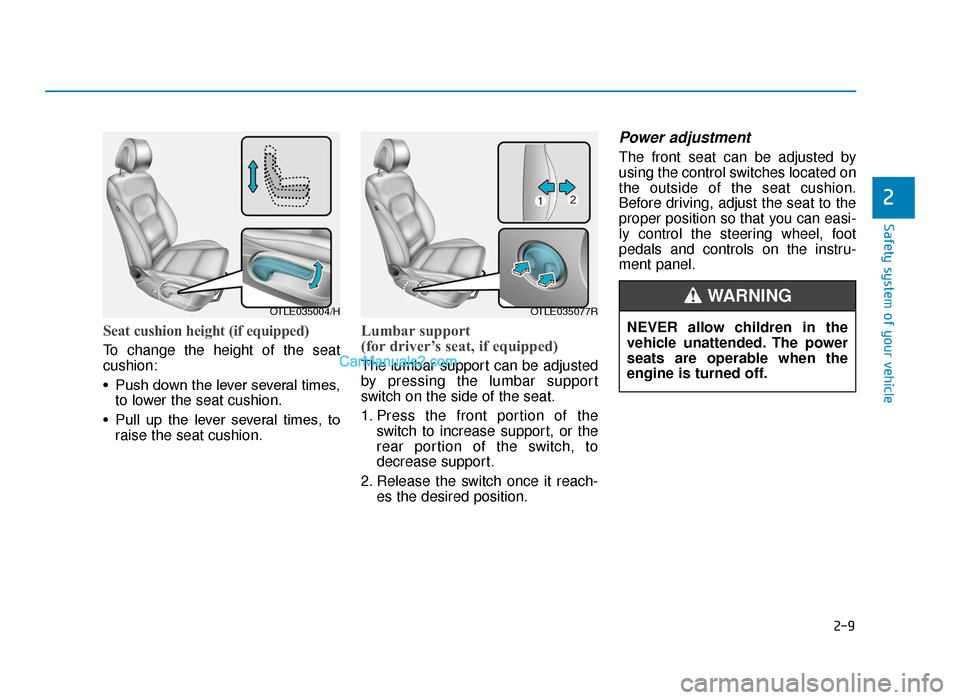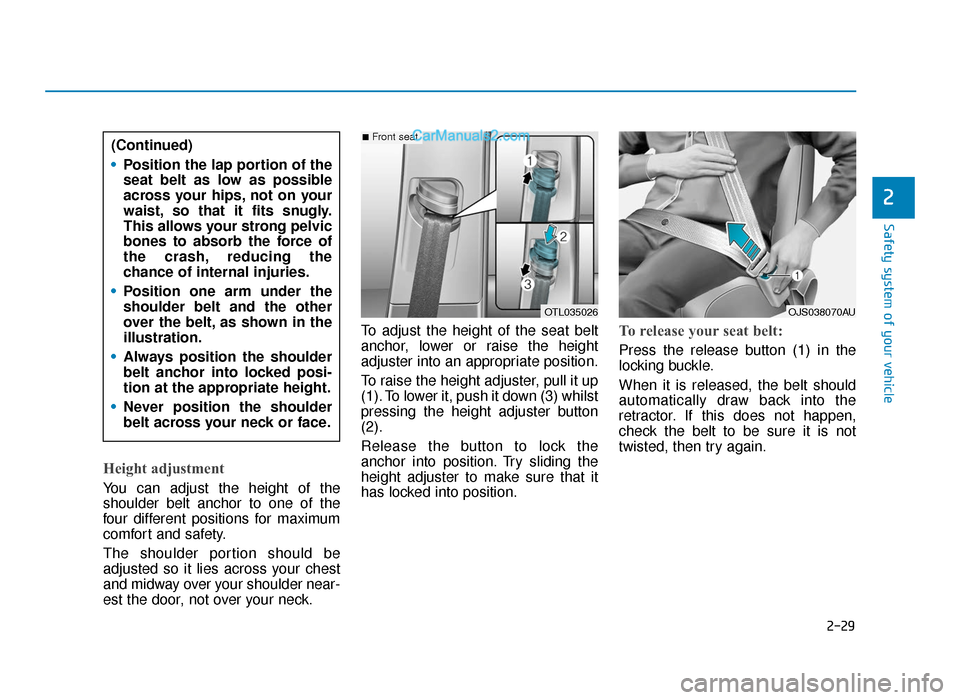Page 24 of 685
2-4
SEATS
Safety system of your vehicle
OTL035001R
Front seat
(1) Forward and backward
(2) Seatback angle
(3) Seat cushion height (Driver’s seat)
(4) Lumbar support (Driver’s seat)*
(5) Seat warmer*
(6) Air ventilation seat*
(7) Head restraint
2nd row seat
(8) Seatback angle and folding
(9) Head restraint
(10) Armrest
(11) Seat warmer*
* : if equipped
■Type A■Type B
TLe UK 2.qxp 6/12/2018 2:03 PM Page 4
Page 29 of 685

2-9
Safety system of your vehicle
Seat cushion height (if equipped)
To change the height of the seat
cushion:
• Push down the lever several times,to lower the seat cushion.
• Pull up the lever several times, to raise the seat cushion.
Lumbar support
(for driver’s seat, if equipped)
The lumbar support can be adjusted
by pressing the lumbar support
switch on the side of the seat.
1. Press the front portion of the switch to increase support, or the
rear portion of the switch, to
decrease support.
2. Release the switch once it reach- es the desired position.
Power adjustment
The front seat can be adjusted by
using the control switches located on
the outside of the seat cushion.
Before driving, adjust the seat to the
proper position so that you can easi-
ly control the steering wheel, foot
pedals and controls on the instru-
ment panel.
2
OTLE035004/HOTLE035077R
NEVER allow children in the
vehicle unattended. The power
seats are operable when the
engine is turned off.
WARNING
TLe UK 2.qxp 6/12/2018 2:03 PM Page 9
Page 31 of 685

2-11
Safety system of your vehicle
2
Reclining seatback
Sitting in a reclined position when
the vehicle is in motion can be dan-
gerous. Even when buckled up, the
protections of your restraint system
(seat belts and air bags) is greatly
reduced by reclining your seatback.Seat belts must be snug against your
hips and chest to work properly.
When the seatback is reclined, the
shoulder belt cannot do its job
because it will not be snug against
your chest. Instead, it will be in front
of you. During an accident, you could
be thrown into the seat belt, causing
neck or other injuries.
The more the seatback is reclined,
the greater chance the passenger’s
hips will slide under the lap belt or
the passenger’s neck will strike the
shoulder belt.
Seat cushion height (if equipped)
To change the height of the seat cush-
ion:
1. • Push the front portion of the con-
trol switch up to raise or down to
lower the front part of the seat
cushion.
• Push the rear portion of the con- trol switch up to raise or down to
lower the height of the seat cush-
ion.
2. Release the switch once the seat reaches the desired position.
NEVER ride with a reclined
seatback when the vehicle is
moving.
Riding with a reclined seatback
increases your chance of seri-
ous or fatal injuries in the event
of a collision or sudden stop.
Driver and passengers should
ALWAYS sit well back in their
seats, properly belted, and with
the seatbacks upright.
WARNING
OTL035051/H
TLe UK 2.qxp 6/12/2018 2:03 PM Page 11
Page 36 of 685
2-16
Safety system of your vehicleTo prevent damage, NEVER hit or
pull on the head restraints.
Front seat head restraints
The driver’s and front passenger’s
seats are equipped with adjustable
head restraints for the passengers
safety and comfort.
NOTICE
When there is no occupant in
the rear seats, adjust the height
of the head restraint to the low-
est position. The rear seat head
restraint can reduce the visibili-
ty of the rear area.
CAUTION
(Continued)
•
Adjust the head restraints so
the middle of the head
restraints is at the same
height as the height of the top
of the eyes.
• NEVER adjust the head
restraint position of the dri-
ver’s seat when the vehicle is
in motion.
• Adjust the head restraint as
close to the passenger’s head
as possible. Do not use a seat
cushion that holds the body
away from the seatback.
• Make sure the head restraint
locks into position after adjust-
ing it.
OLF034072N
OLMB033009
TLe UK 2.qxp 6/12/2018 2:04 PM Page 16
Page 37 of 685
2-17
Safety system of your vehicle
2
Forward and rearward adjustment
The head restraint may be adjusted
forward to 3 different positions by
pulling the head restraint forward to
the desired detent. To adjust the
head restraint to it’s furthest rear-
wards position, pull it fully forward to
the farthest position and release it.
Adjusting the height up and down
To raise the head restraint:
1. Pull it up to the desired position (1).
To lower the head restraint:
1. Push and hold the release button(2) on the head restraint support.
2. Lower the head restraint to the desired position (3). If you recline the seatback towards
the front with the head restraint
and seat cushion raised, the head
restraint may come in contact with
the sunvisor or other parts of the
vehicle.
NOTICE
OTL035014OTL035009OLF034015
TLe UK 2.qxp 6/12/2018 2:04 PM Page 17
Page 39 of 685
2-19
Safety system of your vehicle
2
3. Adjust the head restraint to theappropriate height.
4. Recline the seatback (4) with the seatback angle knob or switch (3).Rear seat head restraints
The rear seats are equipped with
head restraints in all the seating
positions for the passenger’s safety
and comfort.
Adjusting the height up and down
To raise the head restraint:
1. Pull it up to the desired position (1).
To lower the head restraint:
1. Push and hold the release button(2) on the head restraint support.
2. Lower the head restraint to the desired position (3).
OLMB033016
Always make sure the head
restraint locks into position after
reinstalling and adjusting it prop-
erly.
WARNING
OTLE035018
TLe UK 2.qxp 6/12/2018 2:05 PM Page 19
Page 49 of 685

2-29
Safety system of your vehicle
2
Height adjustment
You can adjust the height of the
shoulder belt anchor to one of the
four different positions for maximum
comfort and safety.
The shoulder portion should be
adjusted so it lies across your chest
and midway over your shoulder near-
est the door, not over your neck.To adjust the height of the seat belt
anchor, lower or raise the height
adjuster into an appropriate position.
To raise the height adjuster, pull it up
(1). To lower it, push it down (3) whilst
pressing the height adjuster button
(2).
Release the button to lock the
anchor into position. Try sliding the
height adjuster to make sure that it
has locked into position.
To release your seat belt:
Press the release button (1) in the
locking buckle.
When it is released, the belt should
automatically draw back into the
retractor. If this does not happen,
check the belt to be sure it is not
twisted, then try again.
OTL035026
■Front seat(Continued)
•
Position the lap portion of the
seat belt as low as possible
across your hips, not on your
waist, so that it fits snugly.
This allows your strong pelvic
bones to absorb the force of
the crash, reducing the
chance of internal injuries.
• Position one arm under the
shoulder belt and the other
over the belt, as shown in the
illustration.
• Always position the shoulder
belt anchor into locked posi-
tion at the appropriate height.
• Never position the shoulder
belt across your neck or face.
OJS038070AU
TLe UK 2.qxp 6/12/2018 2:06 PM Page 29
Page 55 of 685

2-35
Safety system of your vehicle
2
Seat belt use and children
Infant and small children
Most countries have Child Restraint
System laws which require children to
travel in approved Child Restraint
System devices, including booster
seats. The age at which seat belts can
be used instead of Child Restraint
System differs among countries, so
you should be aware of the specific
requirements in your country, and
where you are travelling. Infant and
Child Restraint System must be prop-
erly placed and installed in a rear seat.
For more information refer to the “Child
Restraint Systems” in this chapter.Small children are best protected
from injury in an accident when prop-
erly restrained in the rear seat by a
Child Restraint System that meets the
requirements of the Safety Standards
of your country. Before buying any
Child Restraint System, make sure
that it has a label certifying that it
meets Safety Standard of your coun-
try. The Child Restraint System must
be appropriate for your child's height
and weight. Check the label on the
Child Restraint System for this informa-
tion. Refer to “Child Restraint Systems”
in this chapter.
ALWAYS properly restrain infants
and small children in a Child
Restraint System appropriate for
the child’s height and weight.
To reduce the risk of serious
injury or death to a child and
other passengers, NEVER hold a
child in your lap or arms when
the vehicle is moving. The violent
forces created during an acci-
dent will tear the child from your
arms and throw the child against
the interior of the vehicle.
WARNING
TLe UK 2.qxp 6/12/2018 2:07 PM Page 35